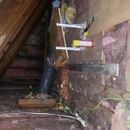Rigid foam, fiberglass, and wiring
Zone 5A
I’m looking at approaches to insulate the attic side of my knee wall. There is currently fiberglass roll insulation between the studs, that continues up the slanted portion of the ceiling, and no air barrier (see attached). I’ve read Martin’s article on the two ways to insulate a knee wall. Ducts are in the attic, which I know is problematic, but I would like to proceed anyway.
I’m thinking about adding 2 inches of rigid foam over the studs, leaving the fiberglass in place. With this approach, my big question is:
What do I do about the wiring in those wall cavities? Is it safe to encase them with insulation? They’re not knob and tube. There are outlets in the knee walls, so wires will have to penetrate somewhere. How do I install the boards, considering the presence of these wires?
GBA Detail Library
A collection of one thousand construction details organized by climate and house part










Replies
It's safe to run romex and other sheathed wiring in contact with rigid foam.
Air tightness is important, so any slots or holes need to be sealed. (Can foam, polyurethane caulk are both pretty good.)
Fire codes often demand that you use only foam board with a fire-rated facer in this application, unless it's covered by an ignition barrier or standard timed thermal barrier such as half inch gypsum board.
It’s technically a no-no to run romex free like it is in that pic — you’re supposed to staple it inside a stud/joist/rafter on the side, run it through the studs/joists/rafters in holes, or put protective furring strips on the sides of the wire if it’s stapled to the edge of those studs. Despite all of that, it’s common to see wire pulled through attics with no attachments like this.
If you have the time and are comfortable working with electrical, the best thing to do would be to drill holes in those studs and run the wire through the holes with the batts split on either side of the wire. If you can’t do that, then I’d staple the wire along the sides of those studs, insulate over it, and then mark the foam board where the wire is as a cautionary note to know not to run screws/nails in that spot. That’s not technically to code, but it’s your best option if you can’t rerun that cable.
Romex (technically NM) wire is safe to run in batts or rigid foam. No worries there.
Bill
This is super helpful information that would not have occurred to me. I'll have to think about that as I move forward.